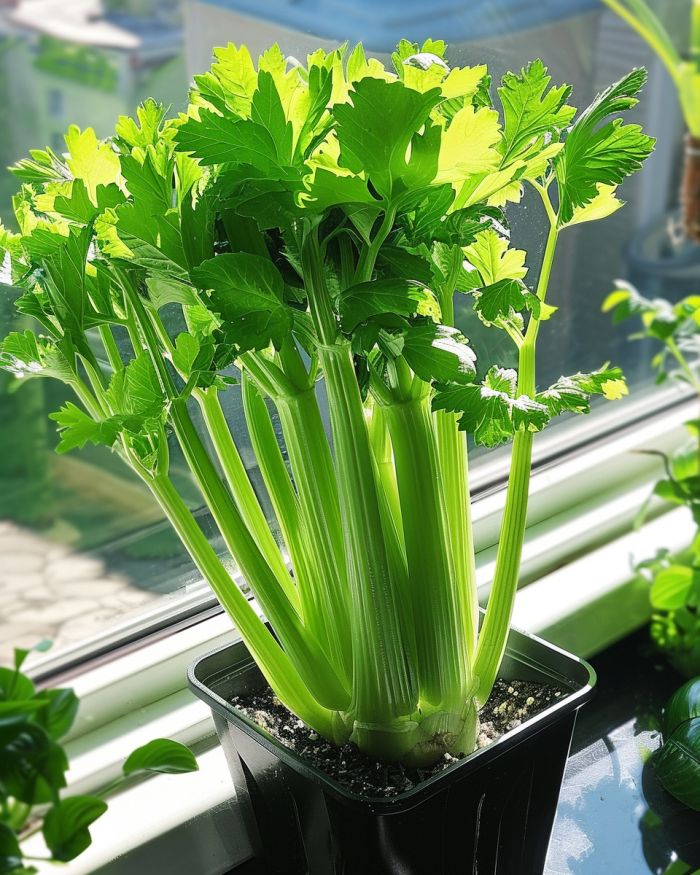By Morgan Reed
Contributing Writer
Growing your own celery at home can be both a delightful and practical endeavor. With rising concerns about food safety, pesticides, and the environmental impact of large-scale farming, there’s never been a better time to cultivate your own produce. Celery, a versatile and nutritious vegetable, can be used in numerous dishes, from soups to salads. By growing your own, you’ll always have a fresh supply at your fingertips and contribute positively to the environment.
Imagine the satisfaction of snipping off fresh stalks of celery right in your kitchen, knowing they were grown by your own hands. In this step-by-step guide, we’ll walk you through everything you need to know to grow your own celery in a pot. This method is designed to be beginner-friendly and easy to follow, ensuring success for anyone with the enthusiasm to try it, whether you’re an experienced gardener or new to the world of home-grown plants.
Why Grow Celery at Home?
Celery is a low-maintenance vegetable that thrives in a variety of environments, making it perfect for growing indoors in pots. Not only will you reduce your carbon footprint by growing your own produce, but you’ll also save money in the long run. Celery is also an excellent source of vitamins and minerals like vitamin K, vitamin C, potassium, and folate, so having a fresh supply at hand means you’re adding a nutritious and versatile vegetable to your daily meals.
Plus, growing celery at home is incredibly rewarding. There’s nothing quite like the satisfaction of snipping a stalk of celery directly from your own garden, and with this easy-to-follow method, you can enjoy a continuous harvest of fresh celery without the hassle of replanting each time. Once you’ve gotten your celery started, it will continue to grow for many months, offering you a never-ending supply right from your windowsill or balcony.
Step 1: Gather Your Supplies and Choose the Right Pot
The first step to growing celery at home is gathering the necessary supplies. Here’s what you’ll need:
- A healthy stalk of celery with the base intact – You can either buy celery from the store or use leftover celery from a previous purchase. Make sure that the stalks are firm, crisp, and fresh, with the base still intact (about 2 inches from the bottom).
- A pot – Choose a pot that is at least 8 inches deep to accommodate the roots. Celery plants develop strong root systems, so they need enough space for their roots to spread and grow. It’s also essential that the pot has drainage holes to prevent the roots from sitting in stagnant water, which could lead to root rot.
- Quality potting soil – Use a good-quality potting mix that is enriched with organic compost. Celery requires nutrient-rich soil for optimal growth, so make sure the soil you choose is well-draining yet retains moisture.
- Water – Celery needs to stay consistently moist, so you’ll need to ensure your plant has access to plenty of water.
With these supplies ready, you can begin the process of growing your own celery.
Step 2: Prepare the Celery Base
Once you’ve gathered your supplies, it’s time to prepare the celery base for planting:
- Cut the celery stalks – Using a sharp knife, cut off the celery stalks from the base, leaving about 2 inches of the bottom of the celery intact. This is the part that will regrow into a new celery plant.
- Rinse the base – Gently rinse the celery base under running water to remove any dirt or debris. You want to ensure that it is clean before placing it in water.
- Place the celery in a shallow bowl of water – Fill a shallow bowl or dish with water and place the celery base in it, ensuring that only the bottom of the celery base is submerged while the top (cut area) remains dry. You should see tiny roots begin to form after a few days.
- Set the bowl in a sunny spot – Position the bowl in a sunny location, like a windowsill, and change the water every couple of days. It typically takes about a week for new roots to develop and for the celery to show signs of new growth.
Step 3: Planting the Celery
Once your celery base has developed enough roots and new growth, it’s time to plant it in a pot. Here’s how to do it:
- Prepare your pot – Fill your pot with potting soil, leaving about an inch at the top to prevent water from spilling out when you water the plant. Make sure the pot is deep enough to allow the roots to spread.
- Make a small hole in the center of the soil – Using your finger or a small stick, make a small hole in the center of the pot.
- Place the celery base inside the hole – Take the celery base, with its roots extending downward, and place it into the hole you’ve made. The new growth should be positioned just above the soil’s surface.
- Pat the soil gently around the base – Once the base is in place, gently pat the soil around it to secure it in position. This helps the roots make good contact with the soil, encouraging healthy growth.
- Water thoroughly – Give the newly planted celery a good drink of water to help settle the soil. Be sure not to saturate the soil too much, as this can cause it to become waterlogged.
Step 4: Caring for Your Celery Plant
Caring for celery once it’s planted is relatively easy but requires a few key factors for success. Here’s how to keep your celery thriving:
- Provide plenty of sunlight – Celery requires at least 6 hours of direct sunlight each day. Ideally, place your pot in a location that gets a good amount of sunlight throughout the day, such as a south-facing windowsill.
- Keep the soil moist – Celery needs consistently moist soil, but not soggy. Water your plant regularly, ensuring the soil stays damp, especially during the warmer months. If the soil dries out too much, your celery plant may stop growing.
- Fertilize regularly – Every 2 to 4 weeks, fertilize your celery with a balanced liquid fertilizer. This will encourage robust growth and help ensure the plant remains healthy. Opt for an organic fertilizer if you prefer a more eco-friendly approach.
- Protect from extreme temperatures – Celery thrives in cooler temperatures (between 50°F and 70°F). Avoid placing it in areas where temperatures can rise too high, as extreme heat can cause the plant to bolt (flower and go to seed prematurely). Likewise, protect it from frost in the colder months, as celery is a cool-season crop.
- Watch out for pests – Keep an eye out for common garden pests such as aphids or slugs. If you notice any pests on your celery, gently wash the plant with a mild soapy solution or use an organic pest control product to keep them in check.
Step 5: Harvesting Celery
After a few weeks, your celery will start to grow tall and develop multiple stalks. Once the stalks reach about 8 inches in height, they are ready to be harvested.
- Harvest the outer stalks first – It’s best to harvest the outermost stalks first, leaving the inner stalks to continue growing. This will encourage the plant to keep producing new growth from the center.
- Use a sharp knife or scissors – To harvest, use a sharp knife or scissors to cut the stalks near the base, just above the root system. You can also break off individual stalks by hand, but cutting them will help avoid damaging the plant.
- Continue to care for your plant – As you harvest, continue to water and fertilize your celery plant, and it will continue to grow and produce new stalks. The plant should keep regenerating new stalks, providing you with a continuous supply of fresh celery.
Tips for Success
- Keep the plant well-watered – Celery is a thirsty plant and requires consistent moisture to thrive.
- Rotate the plant – If your celery is growing unevenly due to the way the light hits it, rotate the pot every few days to ensure all parts of the plant receive equal sunlight.
- Prune when needed – If you notice any dead or yellowing leaves, trim them off to encourage new growth.
- Be patient – Celery grows slowly, so don’t be discouraged if it takes a few weeks before you see substantial growth. Consistent care will reward you with a steady supply of fresh celery.
Conclusion: A Never-Ending Supply of Celery
Growing celery at home is an easy and sustainable way to enjoy a constant supply of fresh, home-grown vegetables. With just a little patience and care, you can have celery growing right in your kitchen or on your balcony year-round. Not only does it add flavor and nutrition to your meals, but it also provides the satisfaction of having grown something from scratch. By following these simple steps, you can create your very own never-ending supply of celery—and in doing so, contribute to a more sustainable and self-sufficient lifestyle. Happy gardening!





